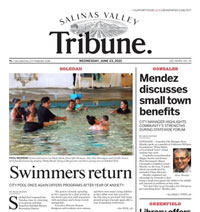
CALIFORNIA — Facing swelling political pressure and numerous lawsuits by businesses forced to shut down, Gov. Gavin Newsom of California on Monday lifted a strict stay-at-home order and handed to local authorities greater control over whether restaurants, hair salons and other commerce could reopen.
The rate of new coronavirus cases in the state has slowed significantly, but experts worry the respite could be brief if the more contagious variants of the coronavirus raging through Europe become prevalent in the United States.
The relaxation of restrictions comes as large parts of Southern California are still recording high death and hospitalization rates and many hospitals in Los Angeles County continue to be overwhelmed with COVID-19 patients.
The changes on Monday do not by any stretch remove all virus-related restrictions in the state. The rescinding of the stay-at-home order, which had already been lifted in the Sacramento area nearly two weeks ago, returns the state to a tiered system of rules tied to the prevalence of the virus in each county.
Dr. Mark Ghaly, secretary of the state’s Health and Human Services Agency, said Monday that the December holidays had not overwhelmed the health care system “to the degree we had feared.”
“California is slowly starting to emerge from the most dangerous surge of this pandemic yet, which is the light at the end of the tunnel we’ve been hoping for,” Ghaly said.
But the latest adjustments were unlikely to placate the large segment of the California population suffering from the economic effects of the pandemic as well as those frustrated and confused by the state’s red-light, green-light approach to managing it.
Driven in large part by restaurant and hotel closures, California’s unemployment rate rose to 9% in December, up nearly a full percentage point from the previous month. It was the first increase in the unemployment rate since April.
Mark Geragos, a lawyer and restaurant owner in Los Angeles who has led lawsuits against the county and state on behalf of businesses forced to close, said Monday that he had reopened his restaurant, Engine Co. No. 28.
His legal actions channeled the frustrations of business owners who felt that many of the orders were arbitrary. In one commonly cited example, movie productions were allowed to proceed, with the cast and crew eating outdoors while nearby restaurants were ordered shut.
“It was government overreach at its worst,” Geragos said of the business closures. He repeated an argument he had used in his lawsuits: “This was not driven by any data or science,” he said.
Newsom said he rushed to lift restrictions as quickly as possible once the numbers indicated it would be safe. He described accusations that he was making pandemic response decisions based on political considerations as “complete, utter nonsense.”
The new rules were a welcome decision for many.
In the Bay Area, officials announced that restaurants would once again be able to reopen for outdoor dining. In Silicon Valley, officials from the Santa Clara Public Health Department announced that in addition to outdoor dining, professional, collegiate and adult and youth sports would be allowed to resume.
When the stay-at-home order was announced in early December, some Californians expressed a mix of anger and futility. Weeks after the order, cases soared and hospitals were overwhelmed.
During the spring, summer and early fall, officials could convincingly argue that the closure of schools, restaurants and barbershops was keeping the virus at levels well below other states. But the winter surge has turned the tables — and, for many, scrambled assumptions about how the virus is spreading.
In November, Newsom and Ghaly held a briefing in which they showed that California ranked 39th in the country in seven-day averages of confirmed cases per capita. Ghaly singled out four states — North Dakota, Wyoming, South Dakota and Minnesota — as having seven-day case rates much higher than California.
Two months later the picture is starkly different: California has gone from 39th to seventh in the same measure, and its one-week average of cases surpassed those four states when adjusted for population. The British variant, believed to be around 50% more transmissible, was first detected in California in December and researchers are tracing the spread of yet another variant that may have played a large part in the winter surge.
California has also slipped below large states with more laissez-faire approaches to virus precautions like Texas and Florida. Both of those states now have fewer cases per capita during the pandemic than California, according to a New York Times database.
Dr. Bob Wachter, a professor and chair of the department of medicine at the University of California, San Francisco, said those metrics can be misleading because they were dependent on how many people get tested.
A better comparison, he said, was the number of deaths. And by this metric California has fared better: Florida has had 24% more deaths per capita, and Texas 27% more.
Wachter said the differences in the death rates in those states represent thousands of lives saved in California.
California’s leaders, he added, are under tremendous pressure to reopen more quickly, and some measures like restricting outdoor dining are difficult to justify with the absence of scientific proof that transmission occurs often in those circumstances.
“But to me in that trade-off, when you’re not sure, you tilt toward safety and saving lives,” he said.
Although praised by many public health officials, the state’s response to the pandemic has put Newsom, a Democrat, in a more vulnerable political position even in this overwhelmingly Democratic state.
The governor has been facing mounting political pressure from a recall effort. Experts have said the vaccine rollout, as well as efforts to reopen, is a key test for his administration.
“The governor’s greatest weakness is around the pandemic,” said Mark Baldassare, the chief executive of the Public Policy Institute of California. “Both in terms of the spread of the disease and the rollout of vaccinations — and that’s been pretty grim.”
On Monday morning, criticism came from all directions.
The California Public Interest Research Group, a left-leaning consumer advocacy organization, said Newsom had acted too early, especially with new variants threatening to hasten the spread of the virus. “We should not risk a backslide in the recent gains we’ve made against this virus just to allow people to go out to eat at a restaurant or get a haircut again,” said Emily Rusch, the executive director of the research group.
Critics of Newsom have also pointed to the state’s slow rollout of vaccines. With 4.7% of California’s population having received at least one dose, the state is below the national average of 5.6% and close to the bottom of the list of vaccination progress.
On Monday, Newsom offered some clarity on the state’s vaccine prioritization framework: Along with health care workers and anyone 65 and older, the state will prioritize emergency medical workers, food and agricultural workers, and teachers and school staff.
After that, he said, the state will “transition to age-based eligibility” and focus on getting vaccines to communities that have been disproportionately affected by the virus.
Newsom said reporting delays had contributed to what he described as misconceptions about the slow relative speed of the vaccine rollout. He compared California to a massive ship.
“It takes a little time to shift course,” he said. “But when it shifts course, it builds tremendous momentum.”
Copyright 2021 The New York Times Company













